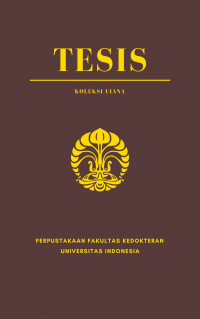Tesis
Variasi Bentuk Arkus Aorta: Teknik Kanulasi Pembuluh Karotis Kaitan Hipertensi, Usia, dan Jenis Kelamin = Variations in Aortic Arch: Carotid Arteries Cannulation Technique Related to Hypertension, Age, and Gender.
Latar belakang: Seorang neurointervensionis untuk melakukan Tindakan neuroendovaskular harus mengetahui pasti struktur karotis dan serebrovaskular, hal ini menentukan keberhasilan tindakan. Bentuk dan perubahan anatomi pembuluh darah menentukan jenis kateter yang digunakan dalam intervensi diagnostik maupun terapetik. Keadaan anatomi yang berbeda-beda dipengaruhi beberapa faktor seperti jenis kelamin, usia, dan kondisi komorbid. Tujuan penelitian ini untuk menentukan faktor predisposisi yang ada, dan dapat memprediksi jenis kateter yang tepat untuk digunakan. Metode: Penelitian deskriptif analitik dengan 57 sampel, dilakukan di Cathlab Pusat Jantung Terpadu (PJT) Rumah Sakit Pusat Nasional Dr. Cipto Mangunkusumo dari Desember 2018 sampai Desember 2021. Faktor-faktor predisposisi dan kondisi komorbid diukur pada setiap pasien. Analisis data dilakukan secara bivariat dan multivariat. Hasil: Variasi lengkung aorta tipe I berjumlah 38, tipe II berjumlah 9 dan tipe III berjumlah 10. Analisis bivariat menunjukkan usia (p < 0,001), jenis kelamin (p=0,256), hipertensi (p=0,089), diabetes melitus (p=0,179), riwayat strok (p=0,882), obesitas (p=0,455), kelainan pembuluh darah intrakranial (p=0,608), letak percabangan arteri karotis komunis (p=0,069), jenis kateter yang digunakan (p=0,425). Analisis multivariat menunjukkan (p=0,026; R2=43%) dengan model usia yang menentukan jenis kateter (p=0,015). Simpulan: Usia adalah faktor prediktor yang dapat memprediksi pemilihan jenis kateter pada pemeriksaan diagnostik maupun terapetik pasien.
Kata kunci: cathlab, jenis kateter, umur, variasi lengkung aorta.
Background: A neurointerventionist to perform neuroendovascular procedures must know for sure the carotid and cerebrovascular structures. Anatomically, this determines the success of the action. Anatomical changes determine the type of catheter used in diagnostic and therapeutic interventions. Different anatomical conditions are influenced by several factors. The purpose of this study was to determine the predisposing factors that can predict the type of catheter used. Methods: Analytical descriptive study with 57 patients, conducted at the Cathlab Center in Dr. National Central Hospital Cipto Mangunkusumo from December 2018 to December 2021. Predisposing factors were measured for each patient. Data analysis was done by bivariate and multivariate. Results: The aortic arch variations of type I were 38, type II was 9 and type III was 10. Bivariate analysis showed age (p < 0.001), sex (p=0.256), hypertension (p=0.089), diabetes mellitus (p= 0.179), history of stroke (p=0.882), obesity (p=0.455), intracranial blood vessel abnormalities (p=0.608), location of the branching of the common carotid artery (p=0.069), type of catheter used (p=0.425). Multivariate analysis showed (p=0.026; R2=43%) with the age model determining the type of catheter (p=0.015). Conclusion: Age is a predictor factor that can predict the choice of catheter type in diagnostic and therapeutic examinations of patients.
Keywords: age, aortic arch variations, cathlab, type of catheter.
- Judul Seri
-
-
- Tahun Terbit
-
2022
- Pengarang
-
Surya Pratama - Nama Orang
Wismaji Sadewo - Nama Orang
Setyo Widi Nugroho - Nama Orang
Hanif G. Tobing - Nama Orang - No. Panggil
-
T22134fk
- Penerbit
- Jakarta : Program Studi Ilmu Bedah Saraf., 2022
- Deskripsi Fisik
-
xv, 60 hal; ill; 21 x 30 cm
- Bahasa
-
Indonesia
- ISBN/ISSN
-
-
- Klasifikasi
-
NONE
- Edisi
-
-
- Subjek
- Info Detail Spesifik
-
Tanpa Hardcopy
| T22134fk | T22134fk | Perpustakaan FKUI | Tersedia |


Masuk ke area anggota untuk memberikan review tentang koleksi